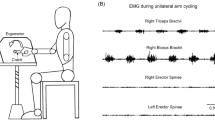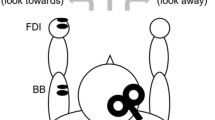Abstract
Trunk muscles receive corticospinal innervation ipsilaterally and contralaterally and here we investigate the degree of ipsilateral innervation and any cortical asymmetry in pairs of trunk muscles and proximal and distal limb muscles. Transcranial magnetic stimulation (TMS) was applied to left and right motor cortices in turn and bilateral electromyographic (EMG) recordings were made from internal oblique (IO; lower abdominal), deltoid (D; shoulder) and first dorsal interosseus (1DI; hand) muscles during voluntary contraction in ten healthy subjects. We used a 7-cm figure-of-eight stimulating coil located 2 cm lateral and 2 cm anterior to the vertex over either cortex. Incidence of ipsilateral motor evoked potentials (MEPs) was 85% in IO, 40% in D and 35% in 1DI. Mean (± S.E.M.) ipsilateral MEP latencies were longer (P<0.05; paired t-test) than contralateral MEP latencies (contralateral vs. ipsilateral; IO: 16.1±0.4 ms vs. 19.0±0.5 ms; D: 9.7±0.3 ms vs. 15.1±1.9 ms; 1DI: 18.3±0.6 ms vs. 23.3±1.4 ms), suggesting that ipsilateral MEPs were not a result of interhemispheric current spread. Where data were available, we calculated a ratio (ipsilateral MEP areas/contralateral MEP areas) for a given muscle (IO: n=16; D: n=8; 1DI: n=7 ratios). Mean values for these ratios were 0.70±0.20 (IO), 0.14±0.05 (D) and 0.08±0.02 (1DI), revealing stronger ipsilateral drive to IO. Comparisons of the sizes of these ratios revealed a bias towards one cortex or the other (four subjects right; three subjects left). The predominant cortex showed a mean ratio of 1.21±0.38 compared with 0.26±0.06 in the other cortex (P<0.05). It appears that the corticospinal control of IO has a strong ipsilateral component relative to the limb muscles and also shows hemispheric asymmetry.




Similar content being viewed by others
References
Barker AT, Jalinous R, Freeston IL (1985) Non-invasive magnetic stimulation of human motor cortex. Lancet 1:1106–1107
Basu AP, Turton A, Lemon RN (1994) Activation of ipsilateral upper limb muscles by transcranial magnetic stimulation. J Physiol 479P:144P
Beith ID, Synnott RE, Newman SA (2001) Abdominal muscle activity during the abdominal hollowing manoeuvre in the four point kneeling and prone positions. Man Ther 6:82–87
Carr LJ, Harrison LM, Evans AL, Stephens JA (1993) Patterns of central motor reorganization in hemiplegic cerebral palsy. Brain 116:1223–1247
Chen R, Yung D, Li JY (2003) Organization of ipsilateral excitatory and inhibitory pathways in the human motor cortex. J Neurophysiol 89:1256–1264
Classen J, Knorr U, Werhahn KJ, Schlaug G, Kunesch E, Cohen LG, Seitz RJ, Benecke R (1998) Multimodal output mapping of human central motor representation on different spatial scales. J Physiol 512:163–179
Colebatch JG, Rothwell JC, Day BL, Thompson PD Marsden CD (1990) Cortical outflow to proximal arm muscles in man. Brain 113:1843–1856
Cracco RQ, Amassian VE, Maccabee PJ, Cracco JB (1989) Comparison of human transcallosal responses evoked by magnetic coil and electrical stimulation. Electroencephalogr Clin Neurophysiol 74:417–424
Day BL, Dressler D, Maertens dN, Marsden CD, Nakashima K, Rothwell JC, Thompson PD (1989) Electric and magnetic stimulation of human motor cortex: surface EMG and single motor unit responses. J Physiol 412: 449–473
Hamdy S, Aziz Q, Rothwell JC, Singh KD, Barlow J, Hughes DG, Tallis RC, Thompson DG (1996) The cortical topography of human swallowing musculature in health and disease. Nat Med 2:1217–1224
Lissens MA, De Muynck MC, Decleir AM, Vanderstraeten GG (1995) Motor evoked potentials of the abdominal muscles elicited through magnetic transcranial brain stimulation. Muscle Nerve 18:1353–1354
Mills KR (1991) Magnetic brain stimulation: a tool to explore the action of the motor cortex on single human spinal motoneurones. Trends Neurosci 14:401–405
Nathan PW, Smith MC, Deacon P (1990) The corticospinal tracts in man. Course and location of fibres at different segmental levels. Brain 113:303–324
Netz J, Lammers T, Homberg V (1997) Reorganization of motor output in the non-affected hemisphere after stroke. Brain 120:1579–1586
Ng JK, Kippers V, Richardson CA (1998) Muscle fibre orientation of abdominal muscles and suggested surface EMG electrode positions. Electromyogr Clin Neurophysiol 38:51–58
Pollock A, Baer G, Pomeroy V, Langhorne P (2003) Physiotherapy treatment approaches for the recovery of postural control and lower limb function following stroke. Cochrane Database Syst Rev CD001920
Porter R, Lemon RN (1995) Corticospinal function and voluntary movement (Monographs of the Physiological Society). Clarendon Press, Oxford
Quartarone A, MacKinnon C, Rothwell JC (1999) Ipsilateral EMG responses in pectoralis major muscle evoked by transcranial magnetic stimulation over the motor cortex. J Physiol 520P:74P
Rothwell JC (1991) Physiological studies of electric and magnetic stimulation of the human brain. Electroencephalogr Clin Neurophysiol Suppl 43:29–35
Tunstill SA, Wynn-Davies AC, Nowicky AV, McGregor AH, Davey NJ (2001) Corticospinal facilitation studied during voluntary contraction of human abdominal muscles. Exp Physiol 86:131–136
Wassermann EM, Fuhr P, Cohen LG, Hallett M (1991) Effects of transcranial magnetic stimulation on ipsilateral muscles [published erratum appears in Neurology (1992) 42:1115]. Neurology 41:1795
Ziemann U, Ishii K, Borgheresi A, Yaseen Z, Battaglia F, Hallett M, Cincotta M, Wassermann EM (1999) Dissociation of the pathways mediating ipsilateral and contralateral motor-evoked potentials in human hand and arm muscles. J Physiol 518:895–906
Acknowledgements
Financial support is gratefully acknowledged from the Arthritis Research Campaign and the International Spinal Research Trust.
Author information
Authors and Affiliations
Corresponding author
Rights and permissions
About this article
Cite this article
Strutton, P.H., Beith, I.D., Theodorou, S. et al. Corticospinal activation of internal oblique muscles has a strong ipsilateral component and can be lateralised in man. Exp Brain Res 158, 474–479 (2004). https://doi.org/10.1007/s00221-004-1939-5
Received:
Accepted:
Published:
Issue Date:
DOI: https://doi.org/10.1007/s00221-004-1939-5




